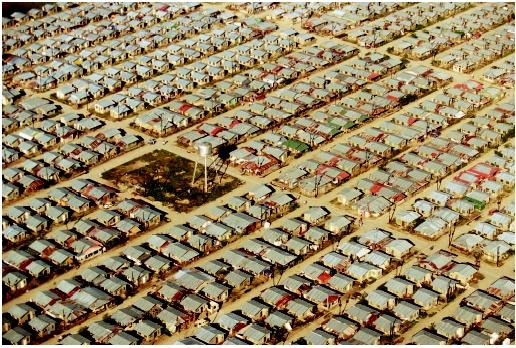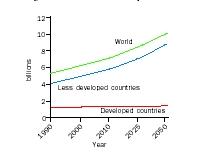Population and Water Resources
People use water for drinking, bathing, cooking, washing clothes, and maintaining lawns and gardens. Water also is used by the manufacturing sector to make products, by the agricultural industry to provide food, and by the energy industry to provide illumination, heat, and air conditioning.
The amount of water used directly by individuals is related to various human attributes such as age, education, cultural background, religious beliefs, and financial status. In general, more people use more water, even if the amount they use individually is reduced by education, the implementation of conservation practices, or technological improvements in watersupply systems.
Water sources in a specific region vary in the quantity and quality of water they contain at a given time, and in their rate and timing of replenishment. If projected withdrawals to meet population growth exceed the ability of the water sources that may be called upon to meet them, then new sources must be developed, if that is possible; otherwise, cutbacks in water use will be required. Yet demands can be decreased only so far until the decreases may endanger public health, damage the environment, or adversely influence the region's economy.

Population Impacts on Future Water Sources
The impacts of population on the quantitative water needs of a locality are related to population density (that is, how the population is distributed geographically), and to the rate of increase or decrease in population growth. Because population changes affect such variables as the economy, the environment, natural resources, the labor force, energy requirements, infrastructure needs, and food supply, they also affect the availability and quality of the water sources that can be drawn upon for use.
Population is highly correlated with public water supply, about 56 percent of which is allocated for domestic (household) purposes. According to the U.S. Geological Survey, the average per capita public water use in the United States in 1995 was about 179 gallons per capita per day (gpcd) and that for domestic water use was about 101 gpcd. An average per capita figure for all water uses in the United States in 1995 (municipal, industrial, agricultural, etc.) was estimated to be about 1,280 gpcd.
The U.S. population in 2000 was about 275.6 million. Projections by the Population Research Bureau indicate a 2025 population of 373.8 million and a 2050 population of 403.7 million. The bureau also reported that the doubling time from the year 2000 for the population of the United States, at its current rate of growth, is about 120 years, for the world 51 years, and for the less developed countries, including China, 36 years. The importance of these estimates can be seen when one notes that about 81 percent of the world's current population resides in less-developed countries.
Future Population Levels.
The world's population reached just over 6 billion in 2000, and it is expected to peak at about 8 to 10 billion sometime this century. According to the Population Reference Bureau, about 7.8 billion people will inhabit the Earth by 2025, and by 2050, the total will reach about 9 billion. More than 90 percent of this growth is expected to take place in less developed nations (see graph), many of which are overpopulated and are stressing their water and other resources. If population projections prove to be reliable, many regions of planet Earth will be facing significant water shortages within the next 50 years.

If the 1995 figure of 1,280 gpcd for all water uses in the United States is multiplied by the bureau's estimate of population in 2025, a rough estimate of water use in that year would be about 508 billion gallons per day. Although uncertainty exists in the population forecast, and technological changes and conservation practices could likely reduce the overall per capita water use in the future, significant increases are expected in populationrelated water use. However, in arid areas of the United States, large increases in water use may not be possible or sustainable unless water is imported or brackish or saline waters are desalinized.
Population Impacts on Future Water Quality
The impact of population on the ability of water sources to meet the demands placed on them by society is paralleled by the effects of population on the quality of water resources. People alter the properties of water as they use it, often degrading the quality with each successive use. Water used in households for drinking, bathing, and cooking becomes contaminated by various chemicals and other constituents introduced during its use. Drainage from water applied in agricultural irrigation carries away chemicals that have been applied to crops to enhance their growth and control weeds and pests. Industries introduce chemicals needed for the manufacture of their products.
As a result of human intervention, waters that have been used for a variety of purposes may contain harmful constituents, including sewage, that pose threats to the environment and to the public health. Their removal can be expensive and difficult.
Issues of water quantity and water quality are inseparable. If the quality of a water source is so degraded that restoring its quality for further use is not feasible, then the source is lost for all practical purposes. Remedial actions are costly, and prevention rather than remediation should be the goal. To achieve it, the public, industries, governments, agencies, and a variety of organizations must all play a positive role.
Reducing Population Impacts
The impacts of future populations on the amount and quality of water resources available for use can be lessened by modifying the local rate of population increase, by modifying the per capita use of water, and by a combination of the two approaches.
A reduction in the per capita use rate for public water has already been demonstrated in the United States. Per capita use decreased from 184 gpcd in 1990 to 179 gpcd in 1995 even though the nation's population increased by 7 percent during that period. Education can play a major role in bringing about such changes.
Water-stressed regions should seek to slow their population growth and reduce their per capita water use to help alleviate their water supply problems. In general, developing nations are growing faster than industrialized nations. Between 2000 and 2050, most all of the world's population growth is projected to take place in developing nations. A reduction of population growth rate in these nations could significantly enhance the likelihood of achieving sustainability for their water supplies.
SEE ALSO Demand Management ; Developing Countries, Issues in ; Food Security ; Supply Development ; Sustainable Development ; Uses of Water .
Warren Viessman Jr.
Bibliography
Cunningham, William P., and Barbara Woodworth Saigo. Environmental Science: A Global Concern, 5th ed. New York: WCB/McGraw-Hill, 1999.
Gleick, Peter H. The World's Water: The Biennial Report on Freshwater Resources 2002–2003. Washington, D.C.: Island Press, 2002.
Tobin, Richard J. "Environment, Population, and the Developing World." In Environmental Policy (4th ed.). eds. Norman J. Vig and Michael E. Kraft. Washington, D.C.: CQ Press, 2000.
Viessman Jr., Warren, and Mark J. Hammer. Water Supply and Pollution Control, 6th ed. Menlo Park, CA: Addison-Wesley, 1998.